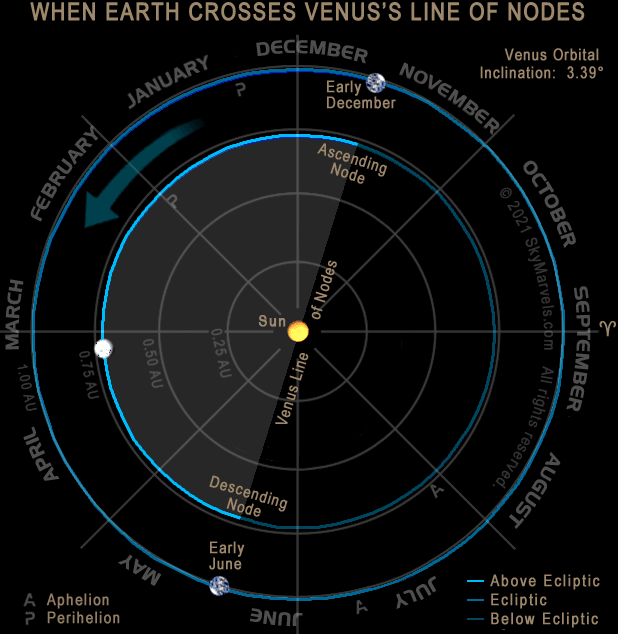
WHEN VENUS'S ORBIT APPEARS "EDGE-ON" FROM EARTH
This is important for determining Venus's transits of the Sun.
Image Credits: NASA/JPL Solar System Simulator developed by: David Seal
EARLY JUNE FOV: 98° Magnification: 0.31x (to show entire orbit) Inner Planet Orbits
L O A D I N G 
Unlike the Superior Planets, the Inferior Planets—Mercury and Venus—have orbits smaller than Earth's. This makes it possible to depict, in a single view, how each one's full orbit would appear from Earth at any instant. In addition, as Mercury's and Venus's orbits are tilted relative to Earth's orbit, both change in "apparent" shape day after day, as Earth circles the Sun. Most often, if you plotted the shapes of Mercury's and Venus's orbits, they would appear to us to be a very narrow ovals that "wobble" around the Sun as Earth progresses in its orbit. But twice each year both Inferior Planets' orbits shrink in thickness to become lines, as we see them "edge on" from Earth.
Though these dates change very slowly over the span of many human lifetimes, viewed from Earth in the current era Venus's orbit appears "edge-on" to us twice a year: in early June and early December. The views directly above and below show this. Venus's orbit is the yellow-ish line segment slightly narrower than each view's overall width.
EARLY DECEMBER FOV: 98° Magnification: 0.31x (to show entire orbit)
The next view—looking down on the inner Solar System—helps us understand why Venus's orbit "flattens into a line" twice a year from our perspective here on Earth. In early June and early December each year, Earth's motion around the Sun carries it through the plane of Venus's orbit, which is tilted 3.39° to the Ecliptic. These same cir- cumstances may be expressed in several ways. For example, it can be said that early June and early December are the times when Earth crosses Venus's line of nodes, the line of intersection of the planes of Venus's and Earth's orbits. It can also be said that these are the times when Venus's line of nodes "points directly at" Earth! These three descriptions are essentially equivalent, and they are important because Venus's orbit is smaller than Earth's.

If Venus is close enough to a node at the proper time in early June or early December, such that it passes directly between Earth and the Sun, then a transit will occur, i.e. the planet will be seen to move across the Sun's disk! At all other times, Venus appears too far from the Sun for a transit to occur. Because both Earth and Venus must be in specific areas of their own orbits at the same time to permit these events, Venus's transits of the Sun occur very rarely, a maximum of twice in a century, and not at all in some centuries! List For example Venus did not transit the Sun at all in the 1400s and 1900s, and it will likewise not transit the Sun at all in the 2500s!
Note that Venus's transits tend to happen in pairs, with the elements of a pair separated by about 8 years. Due to how Earth's and Venus's orbits are synchronized, the pairs of transits themselves alternate in a cycle of 121½ years, succeeded by 105½ years! Venus's last two transits of the Sun occurred on 2004 June 9 and 2012 June 5-6, while its next two will occur on 2117 December 10-11 and 2125 December 8
![]() . Moreover, as these dates already may have suggested to you, each pair of transits occurs with Venus at the same node.
. Moreover, as these dates already may have suggested to you, each pair of transits occurs with Venus at the same node.
With the selectable bonus views directly below you can see how the orientation of Venus's orbit appears to change as seen from Earth throughout the year. Just click through the months or on the month you want to view. With Mercury's smaller orbit visible for reference, it becomes easy to see the relative tilts of Venus's and Mercury's orbits. It is also easy to see that Venus's distance from the Sun does not vary significantly from month to month. This confirms that Venus's orbit is nearly circular—more circular than the orbit of any other major planet!
BONUS: ORIENTATION OF VENUS'S ORBIT BY MONTH FOV: 98° Magnification: 0.31x (to show entire orbit)
The Mercury & Venus 2013-2014 video confirms the changing orientation of Venus's orbit throughout the year. And don't forget to also check out When Mercury's Orbit Appears "Edge-On" from Earth.
Simulator Image Notes: 1) Fields of View are measured horizontally. 2) Orbital views' orientation: Sun's local north "upward", i.e. in the
12:00 midnight direction. 3) Light-Travel Time is not included in calculated times.
Home Intro News Gallery Sky-Gifts Bonuses Tips
Learning Ctr Help Links Credits Legal Contact Us
© 2007-
by Gary M. Winter. All rights reserved.
Interested in political cartoons and humor?
Check out The HIPPLOMATS™.
SkyMarvels, Sky Marvels, SkyMarvels.com, - WHEN VENUS'S ORBIT APPEARS EDGE-ON FROM EARTH, celestia4all, celestiaforall, CELESTIA, astronomy, space, simulations, animations, downloadable astronomy posters, stars, planets, Inner Planets, Outer Planets, Inferior Planets, Superior Planets, moons, asteroids, comets, Oort Cloud, galaxy, galaxies, Milky Way, Andromeda, globular clusters, binaries, quasars, black holes, supermassive black holes, telescope, telescopes, planetarium, software, freestuff, satellites, add-ons, addons, scripts, eclipses, Solar Eclipses, Lunar Eclipses, Solar Eclipse Finder, Lunar Eclipse Finder, mutual eclipses, transits, occultations, Solar System, CELES-TOOLS, celeSTARrium, CELX, CELX programming, Freebies, multiple views, atronomical unit, light year, parsec, meteors, meteor showers, Perseids, Geminids, Leonids, barycenter, time, Time Zones, tides, alignments, conjunctions, oppositions, seasons, apogees, perigees, aphelion, perihelion, Earth, Luna, Mercury, Venus, Mars, Jupiter, Galilean Moons, Io, Europa, Ganymede, Callisto, Saturn, Titan, rings, Uranus, Neptune, Triton, E-MSpectrum, electromagnetic spectrum, astronaut, equinoxes, solstices, precession, rotation, spin, inclination, tilt, Ecliptic, orbits, ellipse, parabola, hyperbola
